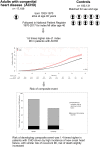Long-term outcomes after myocardial infarction in middle-aged and older patients with congenital heart disease-a nationwide study
- PMID: 33219678
- PMCID: PMC8266664
- DOI: 10.1093/eurheartj/ehaa874
Long-term outcomes after myocardial infarction in middle-aged and older patients with congenital heart disease-a nationwide study
Abstract
Aims: We aimed to describe the risk of myocardial infarction (MI) in middle-aged and older patients with congenital heart disease (ACHD) and to evaluate the long-term outcomes after index MI in patients with ACHD compared with controls.
Methods and results: A search of the Swedish National Patient Register identified 17 189 patients with ACHD (52.2% male) and 180 131 age- and sex-matched controls randomly selected from the general population who were born from 1930 to 1970 and were alive at 40 years of age; all followed up until December 2017 (mean follow-up 23.2 ± 11.0 years). Patients with ACHD had a 1.6-fold higher risk of MI compared with controls [hazard ratio (HR) 1.6, 95% confidence interval (CI) 1.5-1.7, P < 0.001] and the cumulative incidence of MI by 65 years of age was 7.4% in patients with ACHD vs. 4.4% in controls. Patients with ACHD had a 1.4-fold increased risk of experiencing a composite event after the index MI compared with controls (HR 1.4, 95% CI 1.3-1.6, P < 0.001), driven largely by the occurrence of new-onset heart failure in 42.2% (n = 537) of patients with ACHD vs. 29.5% (n = 2526) of controls.
Conclusion: Patients with ACHD had an increased risk of developing MI and of recurrent MI, new-onset heart failure, or death after the index MI, compared with controls, mainly because of a higher incidence of newly diagnosed heart failure in patients with ACHD. Recognizing and managing the modifiable cardiovascular risk factors should be of importance to reduce morbidity and mortality in patients with ACHD.
Keywords: Cardiovascular risk factors; Congenital heart disease; Heart failure; Mortality; Myocardial infarction.
© The Author(s) 2020. Published by Oxford University Press on behalf of the European Society of Cardiology.
Figures





Comment in
-
Congenital heart defects as an intrinsic additional risk factor for the occurrence and outcome of myocardial infarction.Eur Heart J. 2021 Jul 8;42(26):2587-2589. doi: 10.1093/eurheartj/ehaa892. Eur Heart J. 2021. PMID: 33221887 No abstract available.
References
-
- van der Linde D, Konings EE, Slager MA, Witsenburg M, Helbing WA, Takkenberg JJ, Roos-Hesselink JW. Birth prevalence of congenital heart disease worldwide: a systematic review and meta-analysis. J Am Coll Cardiol 2011;58:2241–2247. - PubMed
-
- Mandalenakis Z, Rosengren A, Skoglund K, Lappas G, Eriksson P, Dellborg M. Survivorship in children and young adults with congenital heart disease in Sweden. JAMA Intern Med 2017;177:224–230. - PubMed
-
- Marelli AJ, Ionescu-Ittu R, Mackie AS, Guo L, Dendukuri N, Kaouache M. Lifetime prevalence of congenital heart disease in the general population from 2000 to 2010. Circulation 2014;130:749–756. - PubMed
-
- Marelli AJ, Therrien J, Mackie AS, Ionescu-Ittu R, Pilote L. Planning the specialized care of adult congenital heart disease patients: from numbers to guidelines; an epidemiologic approach. Am Heart J 2009;157:1–8. - PubMed
-
- Afilalo J, Therrien J, Pilote L, Ionescu-Ittu R, Martucci G, Marelli AJ. Geriatric congenital heart disease: burden of disease and predictors of mortality. J Am Coll Cardiol 2011;58:1509–1515. - PubMed
Publication types
MeSH terms
LinkOut - more resources
Full Text Sources
Medical

